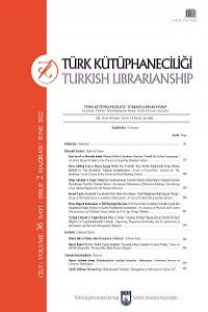El Yazmalarında Belgeleme ve Konservasyon Çalışması: 15. Yüzyıldan Bir Memluk El Yazması
Bu makalede, dönemine uygun biçimde süslenmiş olan 15. yüzyıl Memluk el yazmasının konservasyon çalışmaları üç bölümde ele alınacaktır. İlk olarak el yaz-masının teknik ve hammadde özelliklerini saptamak amacıyla "tanımlama" ya-pılmıştır. İkinci olarak, "konservasyon öncesi durum" başlığı altında objede tes-pit edilen bozulmalar ve nedenleri irdelenmiş, son olarak da objeye uygulanan "konservasyon işlemleri" anlatılmıştır. El yapımı kağıt üzerine siyah ve kırmızı mürekkeple yazılmış olan el yazmasında peygamberler tarihi anlatılmaktadır. Objenin kapakları ve mıklebi murakka kartondan olup üstü keçi derisi ile kaplan-mıştır. Cilt ile metin kısmının birbirinden ayrılmak üzere olması, objenin sayfa-larının "jengar" (bakır içeren pigment) nedeniyle yoğun biçimde hasar görmesi, eski deri ve kağıt onarımlarının işlevini yitirmesi objede tespit edilen bozulma-lardan bazılarıdır. Konservasyon uygulamalarında cilt ve metin kısmı ayrı ayrı işleme alınmış, sağlamlaştırma, tamamlama ve birleştirme yapılmıştır. Makro ve mikro incelemeler ışığında belirlenen bu konservasyon işlemleri Ankara Üniversitesi, Başkent Meslek Yüksekokulu laboratuvarlarmda gerçekleştirilmiştir.
Manuscript Documentation and Conservation Treatment: A Mamluk Manuscript from the 15th Century
The conservation treatment of a 15* century Mamluk manuscript decorated in a manner suitable to the period is considered in three parts. First, with the goal of establishing the manuscript's technical and material characteristics, a "definiti-on" is made; second, under the heading "the pre-conservation condition", the damage observed in the object and its causes are researched; finally, "the con-servation treatments" carried out on the object are explained. The history of prophets, written in black and red ink on handmade paper, is explained in the ma-nuscript. The object's covers and envelope flap are made of laminated paper bo-ard covered with goat leather. Some of the kinds of damage observed in the ob-ject were: The binding and text block were on the point of separating from each other; it suffered considerable losses because of the "jengar" (copper containing pigments) on the object's pages; old restorations had lost their function. During conservation treatment, in the work undertaken separately on the binding and text block, consolidation, filling and mending was done. Guided by macro and micro examinations, this conservation work was carried out in the laboratory of Ankara University, Ba-kent Vocational School.
___
- Arıtan, Ahmet Saim. (1992). Konya dışındaki müze ve kütüphanelerde bulunan Selçuklu ve Selçuk- lu üslubunu taşıyan cild kapakları. (Yayımlanmamış Doktora Tezi). Konya, Selçuk Üniversite-
- Arıtan, Ahmet Saim. (1993). “Cilt”, Îslam Ansiklopedisi, c.7, s. 551-557, İstanbul: Türkiye Cumhuriyeti Diyanet Vakfı.
- Arseven, C. E. (1943-1952)., “Cilt”, Sanat Ansiklopedisi, I. ve II. Cilt, (341-348). İstanbul.
- Banik, G. and J. Ponahlo. (1981). “Some aspects conceming the degradation phenomena of paper caused by green copper containing pigments”, ICOM Committee for Conservation, 6" Triennial Meeting Preprints, 81(14): 1.
- Banik, Gerhard. (1989). “Discoloration of green copper pigments in manuscripts and works of graphie art”, Restaurator, 10: 61-73.
- Baytop, Turhan. (1986). Türkiye’de bitkilerle tedavi, istanbul: Nobel Kitabevi.
- Bosch, G., I. Caswell, and G. Peterbridge. (1981). Islamic biridings and bookmaking, a catalogue on an exhibition, The Oriental Institute, The University of Chicago.
- Bull, William. (1986). “Rebinding Islamic manuscripts: a new direction”, The Institute of Paper Conservation, 14 - 18 April 1986 Oxford, London.
- Caneva, Giulia and Maria Pia Nugari. (1991). Biology in the conservation of works of art, Roma: ICCROM
- Collings, Thomas and Derek Milner. (1978). “The identification of oriental paper—making fibres”, The Paper Conservator 3:51-78.
- Çig, K. (1953). Türk Kitap Kaplan, Ankara: Ankara Üniversitesi Îlahiyat Fakültesi.
- Florian, Mary-Lou. (1997). Heritage eaters, insects and fungi in heritage collections. London: Ja- mes & James.
- Giovanni, Andréa. (1990). “Archäologie des Buches und Konservierende Restaurierung”, Restauro 1.
- Hadgraft, Nicholas. (1994).”The significance of the archaeology of the book in the context of con- servation work”, The First Seminar on the Care and Conservation ofManuscripts Preprins, 25 26 April 1994, Kopenhag
- Haldane, D. (1983). Islamic bookbindings in the Victoria and Albert Museum, London: World of Islam Festival Trust.
- Hickin, Norman. (1985). The insect peste of books, London: Sheppard Press.
- Hoshi, Eriko and Masahiro Kitada. (2002). “Effects of copper on degradation of Japanese wood- block printing paper of the Late Edo era and modem Japanese paper”, HC Congress Preprins, Baltimore, 2-6 September 2002 (100-103).
- ibrahim, Nefeszade. (1939). Gülzar-i Savab, Çev. Kilisli Muallim Rifat, istanbul: Güzel Sanatlar Akademisi.
- James, David. (1980). Qur’ans and bitidings: from the Chester Beatty Library: a facsimilie exhibi- tion. London: World of Islam Festival Trust.
- James, David. (1988). Qur’ans of the Mamluks. Londra: Alexandria Press in association with Tha- mes and Hudson.
- James, David. (1992). The Decorated World, the master scribes: Qur’ans of theh uh to 14' cen- turies AD. The Nasser D. Khalili Collection of Islamic Art.
- Kantarcıoğlu, Serda. (1997). “Kitap arkeolojisi ve konservasyon çalqmasi, XIII. yüzyildan bir Îli- ada nüshasi”, Arkeoloji ve Sanat 20, 86: 38-47.
- Karabacek, von J. (2001). Arab paper, Çev. Don Baker ve Suzy Dittmar, London: Archetype Pub- lications. (34-35).
- Kowalik, Ronnald (1980). “Microbiodeterioration of library materials, part 1”, Restorator (102- 103).
- Loveday, Helen. (2001). Islamic paper. Londra: Archetype Publications.
- Mairinger, Franz. (et all.) (1980). “The destruction of paper green copper pigments, demonstrated by a sample of Chinese wallpaper”, HC Congress Preprints, Vienne (180-184)
- Nicholson, Catherine and Elissa O’Loughlin. (1996). “The use of A-D strips for screening conser- vation and exhibit materials”, The Book and Paper G ro•Rh ftml 15: 83-85.
- Özdeniz, Engin. (1981). “Türk cild sanati”, Sanat Dünyamiz 21.
- Özen, M. E. (1998). Türk cilt sanati, Ankara: Türkiye Χ Bankasi Yayinlari.
- Özen, M. E. (1985). Yazma eserler sözlü§ü, istanbul: istanbul Üniversitesi Edebiyat Fakültesi.
- Steinhäuser, Marianne Harders. (1974). Faseratlas, Biberach: Güntter-Staib Verlag
- Yayın Aralığı: 4
- Başlangıç: 1952
- Yayıncı: Türk Kütüphaneciler Derneği
